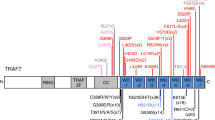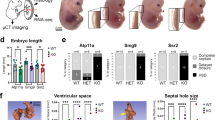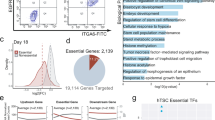Abstract
The transforming growth factor β1 (TGFβ1) signalling pathway1,2 is important in embryogenesis3 and has been implicated in hereditary haemorrhagic telangiectasia (HHT)4,5, atherosclerosis6,7, tumorigenesis8,9 and immunomodulation10,11. Therefore, identification of factors which modulate TGFβ1 bioactivity in vivo is important. On a mixed genetic background, ∼50% Tgfb1−/− conceptuses die mid-gestation from defective yolk sac vasculogenesis3. The other half are developmentally normal but die three weeks postpartum3,10,11. Intriguingly, the vascular defects of Tgfb1−/− mice share histological similarities to lesions seen in HHT patients3–5. It has been suggested that dichotomy in Tgfb1−/− lethal phenotypes is due to maternal TGFβ1 rescue of some, but not all, Tgfb1−/− embryos12. Here we show that the Tgfb1−/− phenotype depends on the genetic background of the conceptus. In NIH/Ola, C57BL/6J/Ola and F1 conceptuses, Tgfb1−/− lethality can be categorized into three developmental classes. A major codominant modifier gene of embryo lethality was mapped to proximal mouse chromosome 5, using a genome scan for non-mendelian distribution of alleles in Tgfb1−/− neonatal animals which survive prenatal lethality. This gene accounts for around three quarters of the genetic effect between mouse strains and can, in part, explain the distribution of the three lethal phenotypes. This approach, using neonatal DNA samples, is generally applicable to identification of loci that influence the effect of early embryonic lethal mutations, thus furthering knowledge of genetic interactions that occur during early mammalian development in vivo.
This is a preview of subscription content, access via your institution
Access options
Subscribe to this journal
Receive 12 print issues and online access
$209.00 per year
only $17.42 per issue
Buy this article
- Purchase on Springer Link
- Instant access to full article PDF
Prices may be subject to local taxes which are calculated during checkout
Similar content being viewed by others
References
Cui, W. & Akhurst, R.J. Transforming growth factor (βs: biochemistry and biology in vitro and in vivo. in Growth factors and cytokines in health and disease, (eds. D. LeRoith and C. Brody) 357–394 (JAI Press, London, 1996).
Massague, J. TGFβ signaling, receptors, transducers and Mad proteins. Cell 85, 947–950 (1996).
Dickson, M.C. et al. Transforming growth factor-β is essential for hematopoiesis and endothelial differentiationin vivo. Development 121, 1845–1854 (1995).
McAllister, K.A. et al. Endoglin, a TGF-β binding protein of endothelial cells, is the gene for hereditary haemorrhagic telangiectasia type 1. Nature Genet. 8, 345–351 (1994).
Johnson, D.W. et al. Mutation in the activin receptor-like kinase 1 gene in hereditary haemorrhagic telangiectasia type 2. Nature Genet. 13, 189–195 (1996).
Grainger, D.J., Kemp, P.R., Liu, A.C., Lawn, R.M. & Metcalfe, J.C. Activation of transforming growth factor-β is inhibited in transgenic apolipoprotein (a) mice. Nature 370, 460–462 (1994).
Grainger, D.J. et al. The serum concentration of active transforming growth factor-βis severely depressed in advanced atherosclerosis. Nature Med. 1, 74–79 (1995).
Markowitz, S. et al. Inactivation of the type II TGF-β receptor in colon cancer cells with microsatellite instability. Science 268, 1276–1277 (1995).
Cui, W. et al. TGFβ1 inhibits the formation of benign skin tumours but enhances progression to invasive spindle cell carcinomas in transgenic mice. Cell 86, 531–546 (1996).
Shull, M.M. et al. Targeted disruption of the mouse transforming growth factor-β1 gene results in multifocal inflammatory disease. Nature 359, 693–699 (1992).
Kulkarni, A.B. et al. Transforming growth factor-β1 null mutation in mice causes excessive inflammatory response and early death. Proc. Natl. Acad. Sci. USA 90, 770–774 (1993).
Letterio, J.J. et al. Maternal rescue of the transforming growth factor β knockout. Science 264, 1936–1938 (1994).
Green, J.B.A. & Smith, J.C. Graded changes in dose of Xenopus activin A homologue elicit stepwise transitions in embryonic cell fate. Nature 347, 391–394 (1990).
Lander, E.S. & Schork, N.J. Genetic dissection of complex traits. Science 265, 2037–2048 (1994).
Dickinson, M.E. et al. Chromosomal localization of seven members of the murine TGF-β superfamily suggests close linkage to several morphogenetic mutant loci. Genomics 6, 505–520 (1990).
Lander, E. & Kruglyak, L. Genetic dissection of complex traits: guidelines for interpreting and reporting results. Nature Genet. 11, 241–247 (1995).
Risch, N., Ghosh, S. & Todd, J.A. Statistical evaluation of multiple-locus linkage data in experimental species and its relevance to human studies: application to nonobese diabetic (NOD) mouse and human insulin-dependent Diabetes Mellitus. Am. J. Hum. Genet. 53, 702–714 (1993).
Laurey, S.G., Barton, D.E., Ullrich, A. & Franke, U. Chromosome mapping of the gene for type II insulin like growth factor receptor/cation-independent mannose-6-phosphate receptor in man and mouse. Genomics 3, 224–229 (1988).
Bonyadi, M., Cui, W., Nagase, H. & Akhurst, R.J., The TGFβ type II receptor, Tgfbr2, maps to distal mouse chromosome 9. Genomics 33, 328–329 (1996).
Qureshi, S., Gros, T., Gros, P., Letarte, M. & Malo, D. The murine endoglin gene (Eng) maps to chromosome 2. Genomics 26, 165–166 (1995).
Avraham, K.B. et al. Mapping of murine fibroblast growth factor receptors refines regions of homology between mouse and human chromosomes. Genomics 21, 656–658 (1994).
Kimelman, D. & Kirschner, M. Synergistic induction of mesoderm by FGF and TGF-β and the identification of an mRNA coding for FGF in the early Xenopus embryo. Cell 51, 869–877 (1987).
Saunders, K.B. & D'Amore, P.A. FGF and TGF-β: Actions and interactions in biological systems. Eukaryot. Gene Expr. 1, 157–172 (1991).
Mock, B.A. et al. The murine interleukin 6 gene maps to the proximal region of chromosome 5. J. Immunol. 142, 1372–1376 (1989).
Gautum, S.C. et al. Transforming growth factor beta1 (TGFβ1) potentiates IL1 alpha-induced IL6 mRNA and cytokine protein production in a human astrocytoma cell line. Oncol. Res. 5, 423–432 (1993).
Liu, J., Baker, J., Perkins, A.S., Robertson, E.J. & Efstradiatis, A. Mice carrying null mutations of the genes encoding insulin-like growth factor I (Igf-1) and type 1 IGF receptor (Igf1r). Cell 75, 59–72 (1993).
George, E.L., Georges-Labouesse, E.N., Patel-King, R.S., Rayburn, H. & Hynes, R.O. Defects in mesoderm, neural tube and vascular development in mouse embryos lacking fibronectin. Development 119, 1079–1091 (1993).
Threadgill, D.W. et al. Targeted disruption of mouse EGF receptor: effect of genetic background on mutant phenotype. Scinence 269, 230–234 (1995).
Rozmahel, R. et al. Modulation of disease severity in cystic fibrosis transmembrane conductance regulator deficient mice by a secondary genetic factor. Nature Genet. 12, 280–287 (1996).
Proetzel, M. et al. Transforming growth factor-β3 is required for secondary palate fusion. Nature Genet. 11, 409–414 (1995).
Neumann, P.E. et al. Multifactorial inheritance of neural tube defects: localization of the major gene and recognition of modifiers in ct mutant mice. Nature Genet. 6, 357–362 (1994).
Lander, E.S. et al. MAPMAKER: An interactive computer package for constructing primary genetic linkage maps of experimental and natural populations. Genomics 1, 174–181 (1987).
Author information
Authors and Affiliations
Corresponding author
Rights and permissions
About this article
Cite this article
Bonyadi, M., Rusholme, S., Cousins, F. et al. Mapping of a major genetic modifier of embryonic lethality in TGFβ1 knockout mice. Nat Genet 15, 207–211 (1997). https://doi.org/10.1038/ng0297-207
Received:
Accepted:
Issue Date:
DOI: https://doi.org/10.1038/ng0297-207
This article is cited by
-
SMAD6-deficiency in human genetic disorders
npj Genomic Medicine (2022)
-
Mechano-regulated cell–cell signaling in the context of cardiovascular tissue engineering
Biomechanics and Modeling in Mechanobiology (2022)
-
TGFβ biology in cancer progression and immunotherapy
Nature Reviews Clinical Oncology (2021)
-
Pericytic Laminin Maintains Blood-Brain Barrier Integrity in an Age-Dependent Manner
Translational Stroke Research (2020)
-
The role of pericytic laminin in blood brain barrier integrity maintenance
Scientific Reports (2016)



